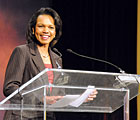
Former U.S. Secretary of State, Condoleezza Rice spoke to the MCAA audience about what is required of creative, innovative, risk-takers in the business world. Rice also educated and entertained the group with her global perspectives.
Coleman hammed it up in a video spoof of “Bullit,” the 1968 movie that featured McQueen in one of the most influential car chase scenes in movie history. Coleman not only passed himself off as a fairly cool stunt driver, but brought waves of laughter to the audience, especially in one scene when he stuffed a rather large donut into his mouth while jumping his Mustang along the hilly streets.
Along with Coleman, many other notable presenters spoke at MCAA, including the Honorable Condoleezza Rice, former U.S. Secretary of State; Tom Flick, performance building expert; and John Koontz, director of MCAA’s National Education Initiative.
STANDING ROOM ONLY
Coleman had the honor of introducing the former U.S. Secretary of State, a much-awaited moment. The packed ballroom overflowed to a standing-room-only crowd - full of attendess all anxious to hear the very popular Rice.Rice brought laughter to the MCAA crowd when she said, “Washington, D.C. is a lot of things, but creative, innovative, and risk-taking are not among them,” as she lauded small businesses in contrast for bringing those three things to the economic recovery.
She also said there are three principles a great country must adhere to in order to remain great. The first is to defend the country and help failed states. Rice cautioned that Afghanistan and Mexico are teetering in the global landscape and are most susceptible to the wrong kind of help. Second, according to Rice, is to control nuclear proliferation. Iran and North Korea are especially troubling at this time. And third is to rebuild the global economy. Leading powers step up to the plate even in hard times of their own, according to Rice.
Rice warmed the audience with a couple of stories of optimism and the American can-do spirit.
“My grandfather, while attending a Presbyterian college, discovered that a fellow student had received a full scholarship to the school. He inquired as to why he could not be granted the same full scholarship as his friend, to which the college spokesperson replied, ‘Well, he wanted to become a minister in the Presbyterian Church. If that were something you had wanted to do, we would have given you a scholarship too.’ To which my grandfather promptly responded, ‘That’s exactly what I have been wanting to do.’ And, to this day, everyone in my family has always received a college education.”
Rice then told the crowd a brief story of a little girl who grew up in Montgomery, Ala., not able to even buy a hamburger at the local Woolworth’s store. However, her parents convinced her that she could some day grow up to be the President of the United States. “And, indeed, she grew up to be the Secretary of State,” said Rice, as she humbly smiled. And, the audience smiled with her.
Rice closed with a comment that brought a standing ovation, “The United States will continue to lead, and the world will be better for it.”
COACHING BEST PRACTICES
Tom Flick, a former college football champion and successful NFL quarterback, and now the president of Tom Flick Communications and The Legacy Coaches Inc., told his audience, “Everyone loves the underdog because everyone has been one at one time or another.”The motivational Flick told everyone that they have got what it takes to make it in this world. He then reminded the crowd of Mary Lou Retton, the American darling of the 1984 Olympics. Retton had just posted the highest score of her life. When she returned from the floor her coach congratulated her and then informed her that she would need another 10 in order to win the overall gold medal. She had what it took to win.
John Koontz knows his audience. At least, that was certainly the case during the MCAA annual convention when Koontz called on audience members to testify to their use of Building Information Modeling (BIM) practices. As if on cue, each contractor spoke about best practices with BIM that were setting them apart in the market.
Koontz said, “BIM jobs are not going out for bid. It’s the new design-build. It’s becoming the new delivery method.”
“The worry about Baby Boomers retiring had abated somewhat when the economy took a dive, but just because there were a lot of laborers on the bench [union labor source]. However, many in the apprentice program don’t actually make it all the way through. Just to stay status quo we need new people coming through the apprentice program. That’s not always happening, so the BIM resource is one resource to be able to do more work with less labor,” said Koontz.
Publication date:06/14/2010




